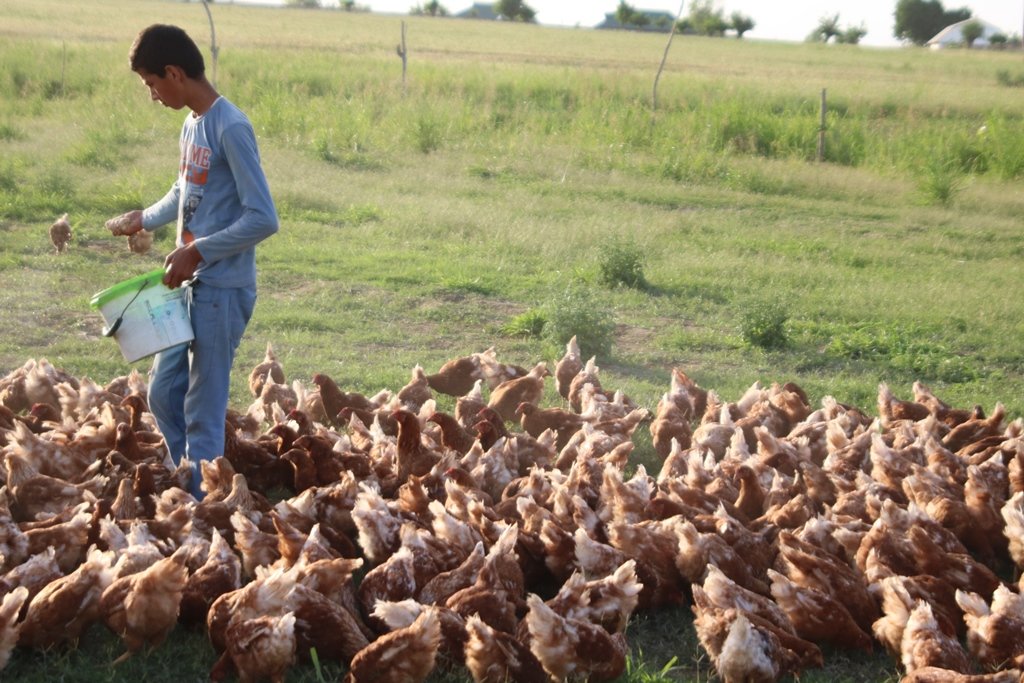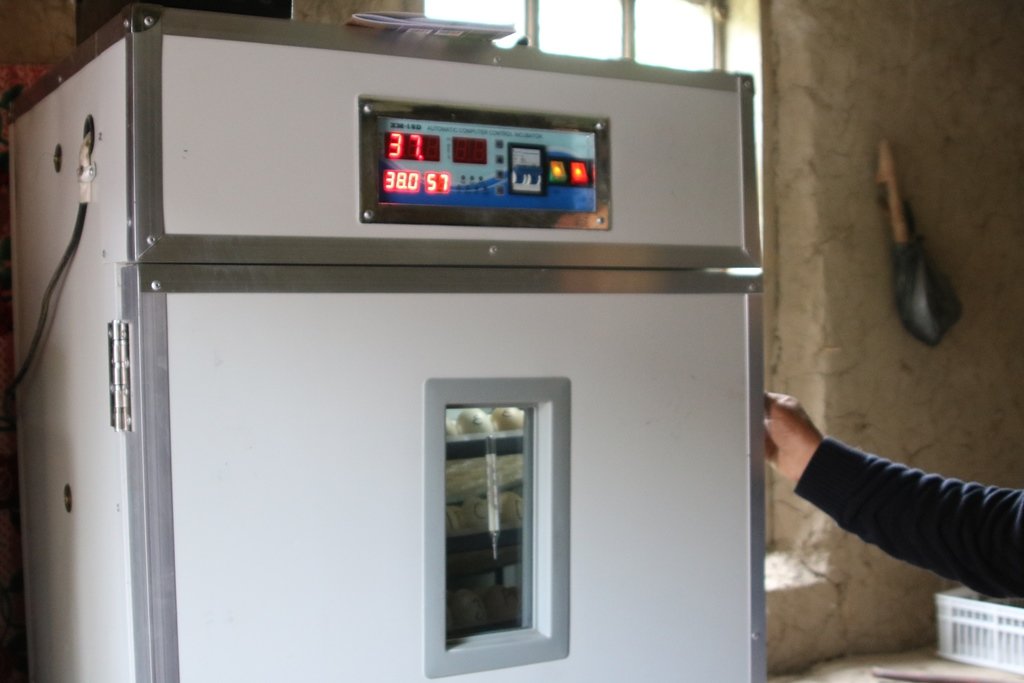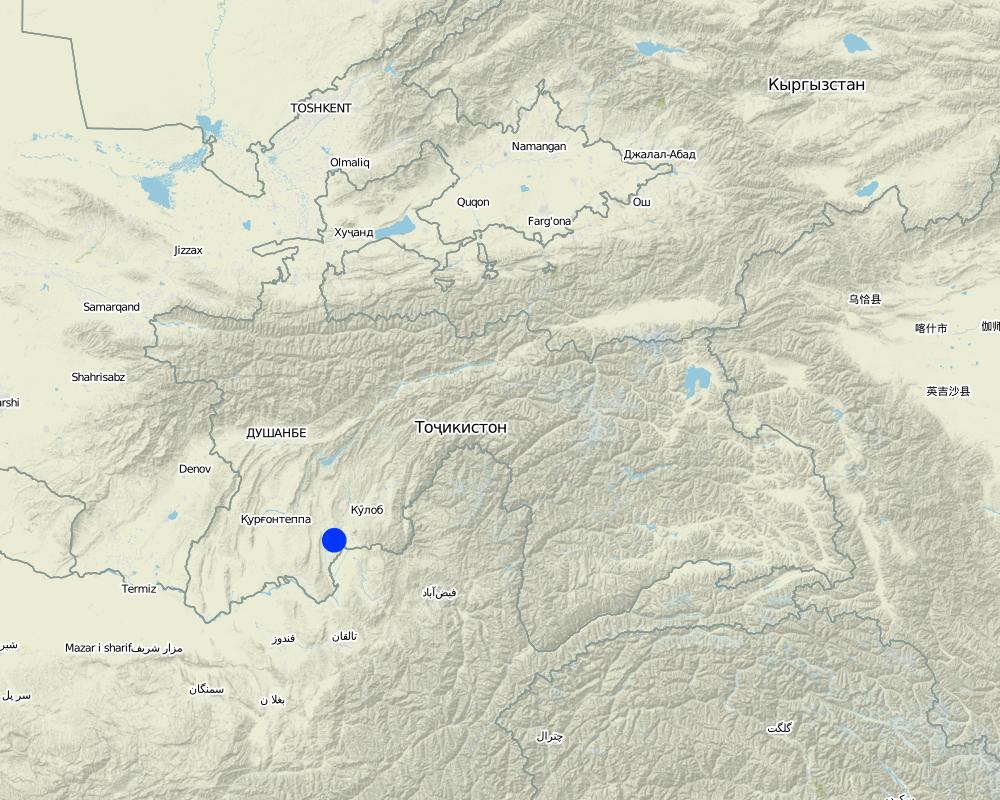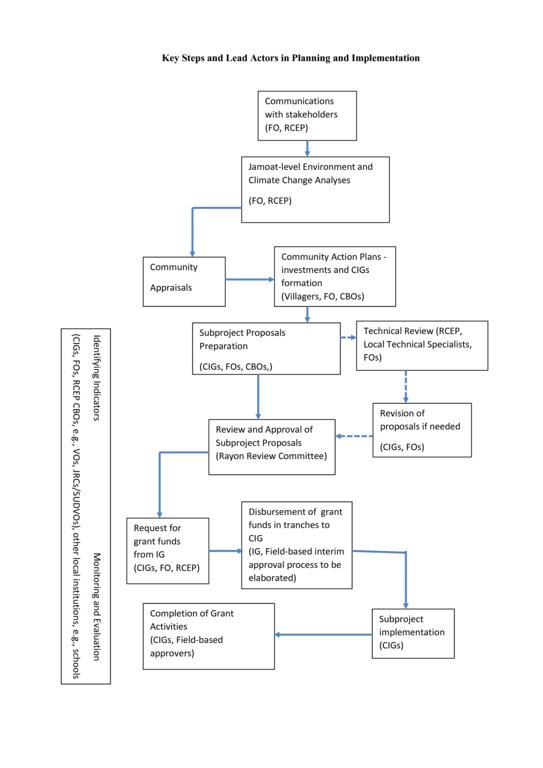Poultry Development gives opportunity to enhance productivity of the lands [Tajikistan]
- Creation:
- Update:
- Compiler: Kamolidin Abdulloev
- Editor: –
- Reviewer: Farrukh Nazarmavloev
Парандапарварӣ
approaches_3891 - Tajikistan
View sections
Expand all Collapse all1. General information
1.2 Contact details of resource persons and institutions involved in the assessment and documentation of the Approach
Key resource person(s)
SLM specialist:
Name of project which facilitated the documentation/ evaluation of the Approach (if relevant)
Environmental Land Management and Rural Livelihoods (ELMAR)Name of the institution(s) which facilitated the documentation/ evaluation of the Approach (if relevant)
Committee for Environment Protection of Tajikistan (Committee for Environment Protection of Tajikistan) - Tajikistan1.3 Conditions regarding the use of data documented through WOCAT
When were the data compiled (in the field)?
27/05/2018
The compiler and key resource person(s) accept the conditions regarding the use of data documented through WOCAT:
Yes
2. Description of the SLM Approach
2.1 Short description of the Approach
Poultry development is a growing sector due to the increasing demand for poultry meat and egg products. But poultry manure is rich in nutrients, which can provide a major source of nitrogen (N), phosphorus (P) and trace elements for crop production. This material can also improve the physical and biological fertility of soil, making it ideal for land application as a fertilizer.
2.2 Detailed description of the Approach
Detailed description of the Approach:
Poultry farming in Somoniyon village is one of the most important activities to date, but the bird flu virus and avian virus annually kill hundreds of birds, which is one of the main problems of the rural people. Local residents spend a lot of money to purchase chickens from different regions, but they do not adapt in today's climate. Taking into account existing difficulties and problems, “Davlatyor” CIG wishes to change the species of birds, purchase such species that can adapt to heat, cold and water resistance, and thereby improve the standard of living for all rural people. Because relief of Somonian village is flat, it has a favorable environment for growing and keeping chickens. Development of this sector can be enhanced to improve the living standards of the rural people and to provide the population with caloric food. People generally establish poultry farm for the purpose of producing eggs, meat and generating high revenue from these products but priority thing for the group is the manure from the birds, as it will enhance the productivity of their lands. The local land users do not use poultry manure directly to their lands as it has low carbon (C):P and N:P ratios and the high potential for loss of N and P through leaching. In addition, overuse or unplanned applications can result in nutrient saturation and consequently environmental loss. That's why before using they mixed with the agriculture wastes from the land plots and prepare organic fertilizer. The group decided to increase the number of the chickens in the beginning as they planned to fertile their households plots. And one of the best way of doing this there were purchasing incubator and quality eggs. At the same time, at the Project expense, an incubator was purchased, which allows to quickly increase the number of chicks in the village as rural people can use it to deliver their chicks and greatly reduce their mortality. During this period the CIG was able to get the species from Khujand (Sughd Oblast), and have got chickens of royal chicks using the incubator. Generally, we brought "Simurg" species, so that to know how to grow them in this region and experience shied that this type of birds can be well-fed in the climate of this region and give desired eggs and meat.
2.3 Photos of the Approach
2.5 Country/ region/ locations where the Approach has been applied
Country:
Tajikistan
Region/ State/ Province:
Kulob Region, Farkhor District
Further specification of location:
Zafar Jamoat, Somoniyon Village
Comments:
An approach implemented in Zafar Jamoat, Salmonchi village
Map
×2.6 Dates of initiation and termination of the Approach
Indicate year of initiation:
2016
Year of termination (if Approach is no longer applied):
2017
Comments:
It was one subproject but the CIG Members resposable for the sustainability of the approach
2.7 Type of Approach
- project/ programme based
2.8 Main aims/ objectives of the Approach
Poultry development will give an opportunity to local land users to enhance the productivity of their lands by using birds manure
2.9 Conditions enabling or hindering implementation of the Technology/ Technologies applied under the Approach
social/ cultural/ religious norms and values
- hindering
Before poultry development improves the living standards of the rural people and to provide the population with caloric food and meet. But implementing this approach help local land users to give priority not only to meet and eggs but to the manure from the birds, as it will enhance the productivity of their lands
availability/ access to financial resources and services
- enabling
The CIG produce more than 350 eggs per day that is cover all the expenditures and also brought to the market for sale, which contributed to enrich the household’s budget. It should be noted that the products of this sector (eggs, meat) is a rapidly digestible product. In addition, this type of activity contributed to the employment of women, who are primarily housewives.
institutional setting
- enabling
The CIG group is formed and will manage and maintain the approach
knowledge about SLM, access to technical support
- hindering
Lack of knowledge on SLM approaches and technologies Organised and provided the different type of SLM training on behalf of the project but it is still an issue.
3. Participation and roles of stakeholders involved
3.1 Stakeholders involved in the Approach and their roles
- local land users/ local communities
Local land Users (CIG Members)
At the beginning of the project activities, the local land users firstly prioritized investments based on a fixed budget for each type of rural investment determined by the number of households. And after within a plan of action, participants decided on the allocation of investments to groups of households using rules that limit the funding for any one household.
- SLM specialists/ agricultural advisers
Representatives from the Facilitation Organisations and Academies
Representatives from the facilitating organizations and professors (as TOT trainers) from the Institutions and academies involved during the training
- local government
Local hukumat reprezentatives
Jamoat representatives were involved during the Participatory Rural Appraisal (PRA) that was used as the main pre-assessment mechanism to analyze the socio-economic and environmental situation in the selected pilots, The RRC (Rayon Review Committee) that were representatives of the local district hukumat reviewed and accepted all subproject proposals at the district level.
3.2 Involvement of local land users/ local communities in the different phases of the Approach
| Involvement of local land users/ local communities | Specify who was involved and describe activities | |
|---|---|---|
| planning | passive | The local land Users(CIG Members) interviewed and consulted during the social assessment conducted in the project design process which then influenced project approaches. |
| implementation | interactive | Land Users(CIG Members) made grant allocation decisions and managed grant funds plus purchased needed materials and products individually |
| monitoring/ evaluation | passive | Representatives of the mentioned groups have actively participated in the process of monitoring |
3.3 Flow chart (if available)
Description:
Here is the key steps and actors that contribute to the planning, implementation and rural investments. Not all possible participants in these steps are included since local situations may vary and will need to be taken into account during planning and implementation.
Author:
ELMARL POM
3.4 Decision-making on the selection of SLM Technology/ Technologies
Specify who decided on the selection of the Technology/ Technologies to be implemented:
- mainly land users, supported by SLM specialists
Explain:
Local Land Users prioritized investments based on a fixed budget for each type of rural investment determined by the number of households and within a plan of action, participants decided on the allocation of investments to groups of households (Common Interest Groups, CIGs) using rules that limit the funding for any one household.
Specify on what basis decisions were made:
- evaluation of well-documented SLM knowledge (evidence-based decision-making)
- Project initial phases
4. Technical support, capacity building, and knowledge management
4.1 Capacity building/ training
Was training provided to land users/ other stakeholders?
Yes
Specify who was trained:
- land users
- field staff/ advisers
If relevant, specify gender, age, status, ethnicity, etc.
All activities, including PRA, training and investment subprojects involved men and women with due a diligence. Social safety was assured for the people with disabilities, who participated in rural livelihoods activities and had equal rights and voices.
Form of training:
- on-the-job
- farmer-to-farmer
- public meetings
Subjects covered:
Grant allocation mechanisms. Fund flow arrangements, management and technical, SLM training
Comments:
There were provided training on these themes; composting, mulching, managing salinization, intercropping on slopes, drip irrigation, low-cost watering techniques, solar greenhouses, drought-resistant crops, bee-keeping, mixed fruit orchards, local varieties nurseries, rotational grazing, Livestock breeding and maintaining, strategic watering points, use of perennial forage, solar energy technologies, marketing options and opportunities,
4.2 Advisory service
Do land users have access to an advisory service?
Yes
Specify whether advisory service is provided:
- on land users' fields
- at permanent centres
Describe/ comments:
Jamoat representatives advise CIG members and support them in realisation their plans
4.3 Institution strengthening (organizational development)
Have institutions been established or strengthened through the Approach?
- yes, a little
Specify the level(s) at which institutions have been strengthened or established:
- local
Describe institution, roles and responsibilities, members, etc.
The Common Interest Groups formed in the villages on behalf households and enhanced their knowledge. And the project provides small-scale grants at the village level for groups of households (CIG) to implement rural production and land management investments, as well as related small-scale infrastructure investments. Villages will prioritize investments based on a fixed budget for each type of rural investment, determined by the number of households.
Specify type of support:
- financial
- capacity building/ training
Give further details:
Project-financed grants to CIGs for each investment under categories of rural production and land management investments, as well as related small-scale infrastructure investments that will not exceed US$7,000 and will require a match of 25% in beneficiary contributions which may be in cash or in-kind
4.4 Monitoring and evaluation
Is monitoring and evaluation part of the Approach?
Yes
Comments:
The process of monitoring covered mainly; grant allocation – the number of beneficiaries, Estimated costs of rural investments, environmental aspects, management of the investments
If yes, is this documentation intended to be used for monitoring and evaluation?
Yes
Comments:
Rural investment monitoring should focus on the range of issues relevant to subproject sustainability, including environmental, social and economic. FOs build CIG capacities to monitor these aspects and to adapt to changing conditions.
4.5 Research
Was research part of the Approach?
No
5. Financing and external material support
5.1 Annual budget for the SLM component of the Approach
If precise annual budget is not known, indicate range:
- 2,000-10,000
Comments (e.g. main sources of funding/ major donors):
GEF/PPCR through WB
5.2 Financial/ material support provided to land users
Did land users receive financial/ material support for implementing the Technology/ Technologies?
Yes
If yes, specify type(s) of support, conditions, and provider(s):
The Common Interest Groups formed at village level on behalf of households and enhanced their knowledge. Further project financed CIG with the small grants under the three main categories of activities that are expected to contribute to their assets and sustainable land management, and increase climate resilience.
An approach/subproject been supported by the grant amount and implemented through the Common Interest Group (CIG). CIG has contributed more than 25% of the total approach/subproject amount. CIG used this opportunity and purchased an incubator and eggs
5.3 Subsidies for specific inputs (including labour)
- none
If labour by land users was a substantial input, was it:
- voluntary
Comments:
As mentioned above beneficiary contribution was as an kind or sometimes as cash because the 25% from the total subproject amount were CIG contribution.
5.4 Credit
Was credit provided under the Approach for SLM activities?
No
5.5 Other incentives or instruments
Were other incentives or instruments used to promote implementation of SLM Technologies?
No
6. Impact analysis and concluding statements
6.1 Impacts of the Approach
Did the Approach empower local land users, improve stakeholder participation?
- No
- Yes, little
- Yes, moderately
- Yes, greatly
The project established CIG at village level who were land users, and community members. During the implementation of the approach been involve other stakeholders from the district they were: jamoat representatives, district veterinarian, and active community members.
Did the Approach help land users to implement and maintain SLM Technologies?
- No
- Yes, little
- Yes, moderately
- Yes, greatly
An approach shows it's results during the implementation and benefit not only the CIG members but other farmers also. After this project people from the other villages and districts visit this project and plan to organize such kind of activities
The provided project trainings (composting, mulching, managing salinization, inter cropping on slopes, drip irrigation, low-cost watering techniques, solar greenhouses, drought resistant crops, bee-keeping, mixed fruit orchards, local varieties nurseries, rotational grazing, Livestock breeding and maintaining, strategic watering points, use of perennial forage) were somehow contribute to the SLM approuches and technologies. And CIG members trying all their best to increase number of the chickens and expand approach among other land users in the village.
Did the Approach improve access to markets?
- No
- Yes, little
- Yes, moderately
- Yes, greatly
There are more than 350 eggs per day they have received that give them the opportunity to cover all their expenditures and also provide additional products to the local market.
Did the Approach lead to employment, income opportunities?
- No
- Yes, little
- Yes, moderately
- Yes, greatly
It should be noted that the products of this sector (eggs, meat) is a rapidly digestible product that is contributed to the employment of women, who are primarily housewives.
6.2 Main motivation of land users to implement SLM
- increased production
Poultry development is a growing sector due to the increasing demand for poultry meat and egg products. But poultry manure is rich in nutrients, which can provide a major source of nitrogen (N), phosphorus (P) and trace elements for crop production. This material can also improve the fertility of soil, making it ideal for land application as fertilizer.
- environmental consciousness
Chicken manure for vegetable garden fertilizing will produce excellent soil for vegetables to grow in. It will be a visible result that vegetables will grow bigger and healthier as a result of using chicken manure fertilizer
- enhanced SLM knowledge and skills
There were provided training on these themes; composting, mulching, managing salinization, intercropping on slopes, drip irrigation, low-cost watering techniques, solar greenhouses, drought-resistant crops, bee-keeping, mixed fruit orchards, local varieties nurseries, rotational grazing, Livestock breeding and maintaining, strategic watering points, use of perennial forage, solar energy technologies, marketing options and opportunities, that more and more SLM approaches and technologies
6.3 Sustainability of Approach activities
Can the land users sustain what has been implemented through the Approach (without external support)?
- yes
If yes, describe how:
The CIG group is formed and will manage and maintain the approach
6.4 Strengths/ advantages of the Approach
| Strengths/ advantages/ opportunities in the compiler’s or other key resource person’s view |
|---|
| The big interest by the land users(CIG Members) |
| Working in the group |
| Income and motivation |
6.5 Weaknesses/ disadvantages of the Approach and ways of overcoming them
| Weaknesses/ disadvantages/ risks in the compiler’s or other key resource person’s view | How can they be overcome? |
|---|---|
| Lack of market and value chance experiance | The need to request to the local government or non government organisations to support them |
| One or two year of the project is not enough time to solve all the group problems | Other projects needs to plan these groups and support them to be more sustainable |
7. References and links
7.1 Methods/ sources of information
- interviews with land users
Local land users (CIG Members)
- interviews with SLM specialists/ experts
ELMARL Agriculture Specialist ELMARL Environmental Specialist
- compilation from reports and other existing documentation
Existing project reports and documents
7.2 References to available publications
Title, author, year, ISBN:
ELMARL Project
7.3 Links to relevant information which is available online
Title/ description:
ELMARL Annual Report 2017
Links and modules
Expand all Collapse allLinks
No links
Modules
No modules






